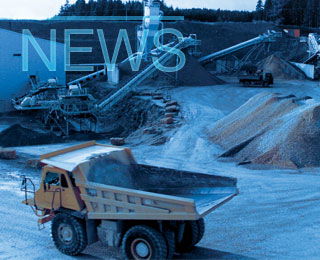Holcim reported strong operating gains in the first half of 2004 and has
posted solid financial results. This encouraging performance was shaped by
an increase in building activity since the second half of 2003 and by more
favorable weather conditions for construction work in Europe and North
America. The unique geographic spread, with a strong focus on growth
markets, was also an important factor in renewed margin improvements, as
were further advances in operating efficiency.
The Group increased sales in all three core segments of cement, ready-mix
concrete and aggregates in all Group regions.
Net sales increased by 8.8 percent to CHF 6,317 million (first half 2003:
5,804) and consolidated operating profit rose by an above-average 21.2
percent to CHF 1,071 million (first half 2003: 884). There was also
significant improvement in consolidated net income after minority interests,
amounting to CHF 370 million (first half 2003: 273). Cash flow from
operating activities also significantly exceeded the year-back result at CHF
688 million (first half 2003: 602).
The first half of 2004 was shaped by two important Group events: the
successful conclusion of the public tender to minority shareholders of
Holcim Apasco, and the equally successful capital increase. The inflow of
some CHF 1.5 billion in new funds enabled Holcim to buy out virtually all
minority shareholders in Mexico and underpin the financial investments made
since the last capital increase with approximately 50 percent shareholders’
equity. This leaves Holcim with a substantially stronger balance sheet.
European construction sector gains momentum The first half of 2004 saw the
European construction sector continue to recover and gather momentum. In
Western Europe, Spain showed the strongest surge in growth, while France and
the Benelux countries also experienced increases in demand. In Germany, the
construction sector failed to make any significant headway against a still
difficult backdrop. In Switzerland, any gains were temporary, and confined
to major projects involving large quantities of cement. However, improving
cement sales in the Switzerland/South Germany region was particularly
supported by the rapid integration of the Dotternhausen cement plant into
the Group. In Italy, cement consumption reached the same high level as the
previous year and demand for construction materials remains robust in
markets supplied by Holcim in Central and Southeast Europe. Overall, in
Group region Europe deliveries increased significantly in all segments. The
first-time consolidation of the majority position in Russia also had a
positive impact on cement sales.
Rising demand for cement in North America In North America, positive demand
growth in the construction sector matched the upturn in the economy as a
whole. The United States in particular experienced an appreciable increase
in demand for construction materials. Alongside housing and road building,
commercial construction projects also generated additional impetus. Even
though the US cement industry operated at capacity in many regional markets,
cement imports were still needed. In Canada, St. Lawrence Cement profited
from the continuing robust economic situation.
In regard to operating results, Group region North America took a major step
forward in local currency terms. In Swiss francs, consolidated operating
profit increased to CHF 95 million (first half 2003: 45) despite the
persistent weakness of the US dollar against the Swiss franc. Efficiency
gains and higher output led to cost savings and in conjunction with higher
prices helped bring about a marked improvement in the result.
In Mexico, Holcim Apasco increased both cement deliveries and sales of
ready-mix concrete and aggregates. Group companies in Central America,
Colombia and Venezuela all posted higher cement volumes. At Holcim Brazil,
delivery quantities contracted somewhat due to continuing sluggish economic
conditions and higher competitive pressure. In Chile, cement consumption
declined slightly as major investments in the infrastructure sector came to
an end. With the completion of construction work on a dam in the south of
the country, Cemento Polpaico’s cement sales also fell back marginally.
Argentinean Minetti recorded consistently solid order levels and a sharp
increase in cement sales.
Business remained robust in North Africa. Holcim Morocco’s sales of cement
and ready-mix concrete were buoyed by an expansion of the transport network
and high demand in housing and tourism. Egyptian Cement maintained stable
volumes and Holcim Lebanon significantly expanded cement deliveries thanks
to an increase in export activity. The Group companies in the Indian Ocean
region also saw cement sales increase.
Holcim South Africa bettered the high benchmarks set the previous year and
expanded sales across all segments. With the commissioning of a third kiln
line at the Dudfield plant, the company directly benefited from the
continuing increase in demand for cement, the additional capacity ensuring
optimized customer deliveries.
Group companies in Australia, New Zealand, Azerbaijan, Vietnam, Sri Lanka
and Malaysia all achieved significant volume growth. Siam City Cement in
Thailand and PT Semen Cibinong in Indonesia also benefited from stronger
domestic demand, but a decline in cement exports left total sales volumes in
these two countries unchanged on balance. Philippines-based Union Cement saw
slightly better cement sales.
